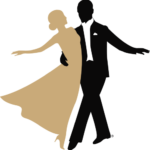The Art of the Rhythm Turn
In the captivating world of ballroom dance, a simple turn can tell a powerful story. For many, ballroom dancing brings to mind the graceful, sweeping movements of international standard dances like the Waltz and Foxtrot. But in the American Rhythm style, turns become something more—a dynamic interplay of syncopated footwork, body motion, and infectious energy.
Standard versus Rhythm: It’s all in the feeling
The distinction between the smooth, flowing turns of standard ballroom and the sharp, rhythmic turns of American Rhythm is a crucial one.
- International Standard and American Smooth dances are primarily built for progress, with turns designed to carry the couple smoothly around the dance floor. In a Waltz, a natural turn is a continuous, clockwise rotation, while a reverse turn is counter-clockwise, with both partners staying in a closed, “standard” embrace. The emphasis is on long, gliding movements and an uninterrupted flow.
- American Rhythm, which includes dances like the Cha-Cha, Rumba, and East Coast Swing, is all about the beat. Here, turns are often punctuated by sharp weight changes, hip action, and more open, social-style movements. Instead of a continuous flow, a Rhythm turn is an energetic burst of motion that reflects the lively, syncopated music.
What is a rhythm turn?
A Rhythm turn is a rotational figure that incorporates the unique timing and body action of the American Rhythm dances. Unlike the sweeping arcs of a Standard turn, Rhythm turns often feel more grounded and percussive. They can be stationary, like a spot turn, or traveling, where a couple turns together as they move across the floor. The secret to a good Rhythm turn lies in the intricate footwork and body control that create speed, flair, and—most importantly—perfect timing with the music.
The secrets to a spectacular rhythm turn
To execute a rhythm turn with that signature flash and precision, dancers focus on a few key mechanics:
- Rotational momentum: Creating and managing your rotational force is critical. In many Rhythm turns, the top half of the body rotates separately from the lower half, creating a spiral action. This allows for a quicker, more elastic turning action that makes a dancer appear both fast and controlled.
- Hip action: American Rhythm places a strong emphasis on hip movement, also known as Cuban motion. This side-to-side and forward-and-back motion of the hips is used to generate torque and initiate the turn. By engaging the hip flexors and knees, a dancer can project rotational power and maintain balance throughout the turn.
- Spotting: Just like in ballet, spotting is essential for maintaining balance during a multi-rotation turn. By keeping your eyes focused on a fixed point in the room for as long as possible, you minimize dizziness and allow your body to orient itself quickly after the turn is complete.
- Sharp, punctuated endings: A key element of many Rhythm turns is the contrast between the quick rotation and a sudden, sharp stop. The explosive energy of the turn is brought to a definitive halt, accentuating the syncopated beat of the music.
Making rhythm turns shine on the dance floor
Whether you’re performing a series of spins in East Coast Swing or a sharp Spot Turn in the Cha-Cha, mastering Rhythm turns is all about embracing the music and the moment.
- Practice your basics: Before you can master a triple spin, you need to be comfortable with your basic footwork. The foundation of many Rhythm turns is based on simple rock steps, walks, and triple steps.
- Focus on connection: A successful partnered turn requires clear lead-follow communication. For example, the leader’s shoulder rotation or foot placement is a cue for the follower to respond, creating a harmonious, powerful turn.
- Add your personal flair: Once you have the technical aspects down, you can start to play with musicality. Listen for accents and changes in the tempo, and use them to add stylistic flourishes, like a dramatic pose or an extra spin.
Rhythm turns are not just a technical requirement but a celebration of the music itself. With focused practice, any dancer can master these explosive and energetic movements, adding a new dimension of flair and rhythm to their dancing.
Ready to try it? Call us today to schedule a lesson with our highly skilled and certified professional dance instructors!


